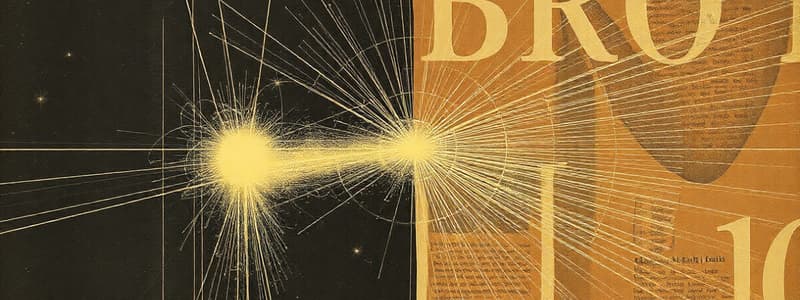Podcast
Questions and Answers
What does the electric field strength (E) at a point depend on?
What does the electric field strength (E) at a point depend on?
- The force experienced per unit positive charge (correct)
- The distance between charges only
- The charge's sign only
- The product of the charges only
How is the direction of the electric field at a point defined?
How is the direction of the electric field at a point defined?
- As the direction of the force on a positive test charge (correct)
- As the direction a negatively charged test charge would move
- As the direction opposite to the electric field lines
- As the direction of a vector pointing toward the source charge
What property of electric field lines indicates the strength of the electric field?
What property of electric field lines indicates the strength of the electric field?
- Their density (correct)
- Their color
- Their direction
- Their length
According to Coulomb's Law, the force between two point charges is influenced by which of the following factors?
According to Coulomb's Law, the force between two point charges is influenced by which of the following factors?
What happens to the electric field lines created by a positive point charge?
What happens to the electric field lines created by a positive point charge?
How should electric fields from multiple point charges be combined?
How should electric fields from multiple point charges be combined?
What does it mean for the electric field to be conservative?
What does it mean for the electric field to be conservative?
What is the unit of electric field strength?
What is the unit of electric field strength?
Flashcards
What is an electric field?
What is an electric field?
A region around a charged object where another charge would experience a force.
What is electric field strength?
What is electric field strength?
The force experienced by a positive test charge divided by the magnitude of the test charge.
What determines the direction of an electric field?
What determines the direction of an electric field?
The direction of the electric field at a point is the direction of the force a positive test charge would experience.
How are electric field lines drawn?
How are electric field lines drawn?
Signup and view all the flashcards
What does the density of electric field lines indicate?
What does the density of electric field lines indicate?
Signup and view all the flashcards
What is the key property of a conservative electric field?
What is the key property of a conservative electric field?
Signup and view all the flashcards
How do you calculate the electric field due to multiple charges?
How do you calculate the electric field due to multiple charges?
Signup and view all the flashcards
What is Coulomb's Law?
What is Coulomb's Law?
Signup and view all the flashcards
Study Notes
Introduction to the Electric Field
- An electric field is a region of space around a charged object where a test charge experiences a force.
- The electric field is a vector field, meaning it has both magnitude and direction.
- The direction of the electric field at a point is defined as the direction of the force that a positive test charge would experience if placed at that point.
- The electric field is a fundamental concept in physics, playing a crucial role in understanding various phenomena such as electricity, magnetism, and light.
Electric Field Strength (E)
- The electric field strength (or electric field intensity) at a point is defined as the force per unit positive charge experienced by a test charge placed at that point.
- Mathematically, E = F/q, where E is the electric field strength, F is the force, and q is the charge.
- Units of electric field strength are Newtons per Coulomb (N/C).
- The electric field strength is a vector quantity.
Properties of the Electric Field
- The electric field is created by electric charges.
- The electric field lines point away from positive charges and towards negative charges.
- The density of electric field lines is proportional to the strength of the electric field.
- Electric field lines never cross.
- The electric field is conservative, meaning that the work done by the electric field on a charge moving along a closed path is zero.
Calculating Electric Fields due to Point Charges
- Coulomb's Law states that the force between two point charges is directly proportional to the product of their charges and inversely proportional to the square of the distance between them.
- The electric field due to a point charge is given by the formula E = k|q|/r2, where k is Coulomb's constant, q is the charge of the source charge, and r is the distance from the source charge.
- The direction of the electric field due to a positive point charge points radially outward, and that due to a negative point charge points radially inward.
Electric Fields Due to Multiple Point Charges
- When multiple point charges are present, the electric field at a point is the vector sum of the electric fields due to each individual point charge.
- This principle is known as the superposition principle.
- Calculating the net electric field involves adding the individual electric field vectors, taking into account their magnitudes and directions.
Electric Field Lines
- Electric field lines are imaginary lines used to visualize the electric field.
- The tangent to a field line at any point gives the direction of the electric field at that point.
- The spacing of the field lines indicates the strength of the electric field; closer lines indicate a stronger field.
Applications of Electric Fields
- Electric fields are crucial in many technologies, including capacitors, particle accelerators, and electronic circuits.
- They are also fundamental to understanding phenomena like lightning, the behavior of electrons in atoms, and the workings of electronic devices.
- In addition, electric fields are used to accelerate charged particles in devices like electron microscopes.
Studying That Suits You
Use AI to generate personalized quizzes and flashcards to suit your learning preferences.




